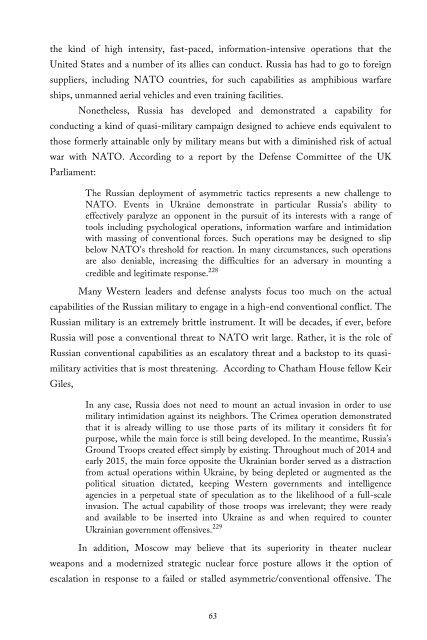Create successful ePaper yourself
Turn your PDF publications into a flip-book with our unique Google optimized e-Paper software.
the kind of high intensity, fast-paced, information-intensive operations that the<br />
United States and a number of its allies can conduct. Russia has had to go to foreign<br />
suppliers, including NATO countries, for such capabilities as amphibious warfare<br />
ships, unmanned aerial vehicles and even training facilities.<br />
Nonetheless, Russia has developed and demonstrated a capability for<br />
conducting a kind of quasi-military campaign designed to achieve ends equivalent to<br />
those formerly attainable only by military means but with a diminished risk of actual<br />
war with NATO. According to a report by the Defense Committee of the UK<br />
Parliament:<br />
The Russian deployment of asymmetric tactics represents a new challenge to<br />
NATO. Events in Ukraine demonstrate in particular Russia's ability to<br />
effectively paralyze an opponent in the pursuit of its interests with a range of<br />
tools including psychological operations, information warfare and intimidation<br />
with massing of conventional forces. Such operations may be designed to slip<br />
below NATO's threshold for reaction. In many circumstances, such operations<br />
are also deniable, increasing the difficulties for an adversary in mounting a<br />
credible and legitimate response. 228<br />
Many Western leaders and defense analysts focus too much on the actual<br />
capabilities of the Russian military to engage in a high-end conventional conflict. The<br />
Russian military is an extremely brittle instrument. It will be decades, if ever, before<br />
Russia will pose a conventional threat to NATO writ large. Rather, it is the role of<br />
Russian conventional capabilities as an escalatory threat and a backstop to its quasimilitary<br />
activities that is most threatening. According to Chatham House fellow Keir<br />
Giles,<br />
In any case, Russia does not need to mount an actual invasion in order to use<br />
military intimidation against its neighbors. The Crimea operation demonstrated<br />
that it is already willing to use those parts of its military it considers fit for<br />
purpose, while the main force is still being developed. In the meantime, Russia’s<br />
Ground Troops created effect simply by existing. Throughout much of 2014 and<br />
early 2015, the main force opposite the Ukrainian border served as a distraction<br />
from actual operations within Ukraine, by being depleted or augmented as the<br />
political situation dictated, keeping Western governments and intelligence<br />
agencies in a perpetual state of speculation as to the likelihood of a full-scale<br />
invasion. The actual capability of those troops was irrelevant; they were ready<br />
and available to be inserted into Ukraine as and when required to counter<br />
Ukrainian government offensives. 229<br />
In addition, Moscow may believe that its superiority in theater nuclear<br />
weapons and a modernized strategic nuclear force posture allows it the option of<br />
escalation in response to a failed or stalled asymmetric/conventional offensive. The<br />
63



